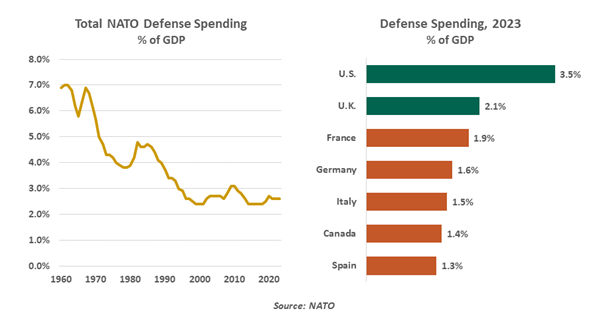- Who We Serve
- What We Do
- About Us
- Insights & Research
- Who We Serve
- What We Do
- About Us
- Insights & Research
NATO By The Numbers
Europe needs to boost defense spending while managing stretched fiscal positions.
By Carl Tannenbaum
I’m writing from London this week, where Sherlock Holmes famously chased clues and criminals. There is a Sherlock Holmes museum here, and one can take a walking tour to visit sites that featured prominently in his adventures.
Believe it or not, Holmes used cocaine to focus his mind. The drug was commonly prescribed in Victorian England for a range of maladies; a seven percent solution was administered. That dosage became the title of a 1974 novel, an homage to Sir Arthur Conan Doyle in which Holmes and Watson foil a villain intent on inciting war in Europe.
In the modern era, a two percent solution has been used to avoid war in Europe. The two percent refers to the fraction of gross domestic product (GDP) that signatories to the North Atlantic Treaty Organization (NATO) are expected to spend on defense. Not all countries are in compliance with this expectation, which has become a sticking point between members and a risk to economic activity.
National security and prosperity are inextricably linked. Threats raise risk premia and divert resources from civilian to strategic applications. The potential for disruption can lead to outmigration of both people and capital. Investment horizons are curtailed amid the possibility of war, hindering long-term development.
NATO was formed in 1949 to coordinate defense among Western Allies. After collaborating during World War II, Western Europe and the Soviet Union found themselves in a Cold War. NATO was formed with twelve countries, whose union served as a counterweight to growing Soviet influence in Eastern Europe. With the continent rebuilding, the United States provided the lion’s share of defense spending for NATO in its early years.
At the height of the Cold War, NATO defense spending as a share of members’ GDP was three times higher than it is today. As détente took hold in the 1970s, and as the fall of the Berlin Wall approached in the 1980s, Western countries were able to reap a “peace dividend.” The fraction of GDP devoted to security by NATO members has been fairly constant for the past 20 years.

Defense spending in Europe needs reinforcement.
In the wake of Russia’s annexation of Crimea in 2014, NATO adopted the 2% rule to ensure sufficient financial commitment to security. That goal was to be reached over a ten year period. As of last year, only 11 of the 32 member countries met this objective; some important European names fell short. That is not a good position to be in with Russian aggression increasing.
In recent years, gaps in NATO defense spending have become more of an issue with the United States, which is facing a deteriorating fiscal position. Some have suggested that European countries have gained competitively by using resources for development instead of deterrence. The situation is certain to be a focus during the 2024 U.S. presidential campaign.
The challenge is that national budgets in Europe are also stretched. The updated growth and stability pact is limiting fiscal freedom. Annual shortfalls will once again be capped at 3% of GDP, leaving little room for more defense spending. Europe’s governments are also seeking to engineer a successful energy transition and modernize technology, all while dealing with the collective costs of aging populations. The calculus is very difficult.
With the 10-year checkpoint approaching, 18 of the 32 NATO countries say that they will meet the 2% requirement. That represents an improvement, but it also represents only 56% compliance. If peace and prosperity are to be preserved, Europe will want to do better.
Perhaps we can borrow a magnifying glass from Sherlock Holmes to find clues on where funding can be found in national ledgers. Hopefully, the solution will be…elementary.
Related Articles
Read Past Articles
Meet Our Team

Carl R. Tannenbaum
Chief Economist

Ryan James Boyle
Chief U.S. Economist

Vaibhav Tandon
Chief International Economist
Subscribe to Publications on Economic Trends & Insights
Gain insight into economic developments and our latest forecasts for the United States.
Information is not intended to be and should not be construed as an offer, solicitation or recommendation with respect to any transaction and should not be treated as legal advice, investment advice or tax advice. Under no circumstances should you rely upon this information as a substitute for obtaining specific legal or tax advice from your own professional legal or tax advisors. Information is subject to change based on market or other conditions and is not intended to influence your investment decisions.
© 2025 Northern Trust Corporation. Head Office: 50 South La Salle Street, Chicago, Illinois 60603 U.S.A. Incorporated with limited liability in the U.S. Products and services provided by subsidiaries of Northern Trust Corporation may vary in different markets and are offered in accordance with local regulation. For legal and regulatory information about individual market offices, visit northerntrust.com/terms-and-conditions.